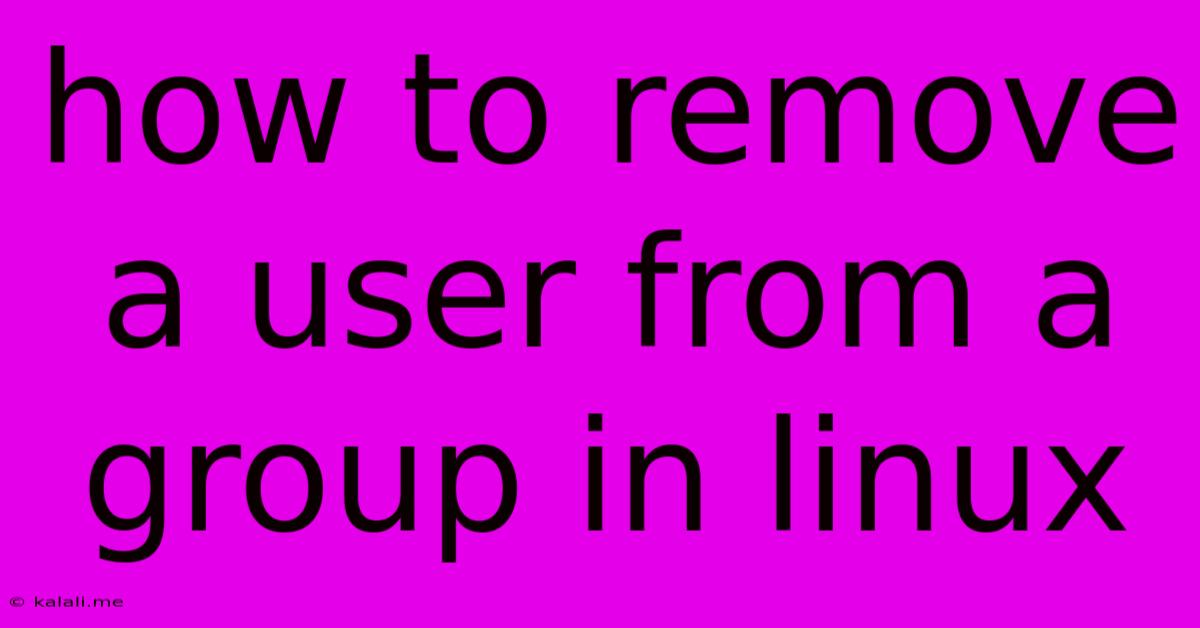How To Remove A User From A Group In Linux
Kalali
Jun 03, 2025 · 3 min read

Table of Contents
How to Remove a User from a Group in Linux: A Comprehensive Guide
Removing a user from a group in Linux is a common administrative task, crucial for managing user permissions and security. This guide provides a step-by-step process, covering various methods and scenarios you might encounter. This will ensure you can efficiently manage user access to system resources and maintain a secure Linux environment.
Understanding User Groups in Linux
Before diving into the removal process, understanding the role of groups is crucial. Groups in Linux are collections of users who share similar access privileges to system resources. Assigning users to specific groups allows administrators to grant permissions based on roles or responsibilities, rather than individually managing access for each user. This simplifies administration and enhances security. Understanding this foundational aspect is key to performing this task correctly and safely.
Methods to Remove a User from a Group
There are primarily two common methods to remove a user from a group in Linux: using the gpasswd command and using the deluser command (although deluser is less common and may not be available on all distributions). We'll explore both.
Method 1: Using the gpasswd command
The gpasswd command is the standard and most widely used method for managing groups. It’s generally preferred due to its straightforward syntax and widespread availability across various Linux distributions.
Here's how to use it to remove a user from a group:
sudo gpasswd -d username groupname
sudo: This ensures you have the necessary administrative privileges to modify group membership.gpasswd: This is the command-line utility for managing group memberships.-d: This option specifies that you're deleting a user from the group.username: Replace this with the actual username you want to remove.groupname: Replace this with the name of the group from which you're removing the user.
Example: To remove the user john from the group developers, you would use the following command:
sudo gpasswd -d john developers
After executing this command, the user john will no longer be a member of the developers group. This change takes effect immediately. Verify the changes using the commands in the verification section below.
Method 2: Using the deluser command (less common)
Some Linux distributions might include the deluser command, which offers a more comprehensive approach to user management. While functional, gpasswd remains the more prevalent and recommended approach for simply removing a user from a group. If you choose to use deluser, the command structure would be similar to this:
sudo deluser username groupname
However, it’s important to note that the deluser command might handle additional aspects of user removal, potentially impacting the user's home directory or other associated files. Therefore, gpasswd is generally recommended for the specific task of removing a user from a group to prevent unintended consequences.
Verifying the Changes
After removing a user from a group, it's crucial to verify the change. You can use the following commands:
-
groups username: This command lists all the groups a user belongs to. If the user has been successfully removed, the group name should not appear in the output. -
cat /etc/group: This displays the contents of the/etc/groupfile, which lists all groups and their members. You can manually check if the username is no longer listed under the specified group.
Troubleshooting Common Issues
-
Permission Errors: If you encounter permission errors, ensure you're running the command with
sudoto gain root privileges. -
Incorrect Group Name or Username: Double-check the spelling of both the username and the group name for typos. Case sensitivity is important in Linux.
-
Non-existent User or Group: Verify that both the user and the group actually exist on the system before attempting removal.
By following these steps and understanding the potential issues, you can confidently and efficiently remove users from groups in your Linux environment, maintaining a secure and well-organized user management system. Remember to always verify your changes to ensure the operation was successful.
Latest Posts
Latest Posts
-
Wd My Passport Ext4 Format Slow
Jun 04, 2025
-
How Does Rhythms And Bars Factor Into Lyrics
Jun 04, 2025
-
Macos High Sierra Bootable Usb Flash Drive Installer
Jun 04, 2025
-
Dexron 3 Transmission Fluid For Power Steering
Jun 04, 2025
-
How To Say I Dont Speak French In French
Jun 04, 2025
Related Post
Thank you for visiting our website which covers about How To Remove A User From A Group In Linux . We hope the information provided has been useful to you. Feel free to contact us if you have any questions or need further assistance. See you next time and don't miss to bookmark.